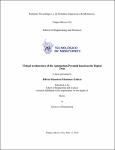| dc.contributor.advisor | Ponce Cruz, Pedro | |
| dc.contributor.author | Martinez Galicia, Edwin Mauricio | |
| dc.creator | PONCE CRUZ, PEDRO; 31857 | |
| dc.date.accessioned | 2022-11-14T21:18:17Z | |
| dc.date.available | 2022-11-14T21:18:17Z | |
| dc.date.issued | 2022-05-30 | |
| dc.identifier.citation | Martínez Galicia, E. M., (2022). Virtual architecture of the automation pyramid based on the digital twin. (Tesis Maestría) Instituto Tecnológico y de Estudios Superiores de Monterrey. Recuperado de: https://hdl.handle.net/11285/649896 | es_MX |
| dc.identifier.uri | https://hdl.handle.net/11285/649896 | |
| dc.description.abstract | Industry 4.0 has been empowered by new emerging technologies to improve the competitiveness in companies. One of these technologies is the digital twin (DT) which is an advanced virtual model that enables to predict, detect and classify normal and abnormal operating conditions in a factory or a particular production process to improve the features of a physical system.
On the other hand, the manufacturing processes generally follow standards to segment and distribute their processes, information, and implementation areas. Among the most widely recognized standards in the manufacturing industry is the ISA-95 standard that incorporates the business functions and control systems performed in a company with the objective to enhance the implementation of interfaces between business and control systems.
Some architectures, as the Automation Pyramid (AP), hierarchically place the elements that take part in a manufacturing process, from the basic elements such as sensors and actuators, to the decision-making systems, whose functions and shared information are defined in the ISA-95 standard.
In industry, one of the main functions of decision-making systems, such as the Manufacturing Execution System (MES), is to provide critical data in real-time at the operational level to increase productivity and process capability of the manufacturing process. However, these systems usually do not have capabilities to offer a prompt/autonomous/learning-based response to face unpredicted changes in the course of operating resources. Therefore, when a fault condition occurs, not only quick responses are required but also predictive information to prevent future failure scenarios.
Thus, this work proposes to provide responsiveness to decision-making levels in the face of unforeseen scenarios, through the incorporation of intelligent algorithms. The main objectives of this thesis are presented below:
To propose a complete Virtual Architecture of the Automation Pyramid based on the Digital Twin: This enables the simulation of scenarios with elements from the shop-floor to the management levels, considering the advantages that the DT provides.
To align the proposal with international standards: The model is driven by the ISA-95 standard incorporating the functions and information flow defined in it for decision-making levels. %Thus, the decision-making process is into an automation dynamic loop. To provide learning capabilities to the decision-making systems through artificial neural networks, incorporated in a model based on the DT concept: Since neural networks are able to learn and generalize knowledge, they can learn specific conditions for helping the decision-making process.
Evaluate a manufacturing system for educational purposes through the proposed model: The parts of the virtual model of the AP will be identified in a manufacturing cell system used for education at Tec de Monterrey. Its components will be evaluated within the framework of the proposed architecture and the elements to complete the virtual model of the AP will be identified.
As a result, this work proposes the complete virtual model of the Automation Pyramid based on the concept of the Digital Twin, where it is proposed to add autonomy capabilities to the decision-making levels through neural networks. The proposed model is aligned with the international standard ISA-95 as an alternative to be applied directly to a process or factory that can be based on the standard. | es_MX |
| dc.format.medium | Texto | es_MX |
| dc.language.iso | eng | es_MX |
| dc.publisher | Instituto Tecnológico y de Estudios Superiores de Monterrey | es_MX |
| dc.relation.isFormatOf | publishedVersion | es_MX |
| dc.relation.isreferencedby | REPOSITORIO NACIONAL CONACYT | |
| dc.rights | openAccess | es_MX |
| dc.rights.uri | http://creativecommons.org/licenses/by/4.0 | es_MX |
| dc.subject.classification | INGENIERÍA Y TECNOLOGÍA::CIENCIAS TECNOLÓGICAS::TECNOLOGÍA DE LOS ORDENADORES::SISTEMAS DE CONTROL DE PRODUCCIÓN | es_MX |
| dc.subject.lcsh | Technology | es_MX |
| dc.title | Virtual architecture of the automation pyramid based on the digital twin | es_MX |
| dc.type | Tesis de Maestría / master Thesis | es_MX |
| dc.contributor.department | Escuela de Ingeniería y Ciencias | es_MX |
| dc.contributor.committeemember | López Caudana, Édgar Omar | |
| dc.contributor.committeemember | Soriano Avendaño, Luis Arturo | |
| dc.contributor.mentor | Molina Gutiérrez, Arturo | |
| dc.subject.keyword | Automation Pyramid | es_MX |
| dc.subject.keyword | Digital Twin | es_MX |
| dc.subject.keyword | Manufacturing | es_MX |
| dc.contributor.institution | Campus Ciudad de México | es_MX |
| dc.contributor.cataloger | emipsanchez | es_MX |
| dc.description.degree | Master of Science in Engineering | es_MX |
| dc.date.accepted | 2022-05-30 | |
| dc.audience.educationlevel | Empresas/Companies | es_MX |
| dc.identificator | 7||33||3304||120322 | es_MX |



